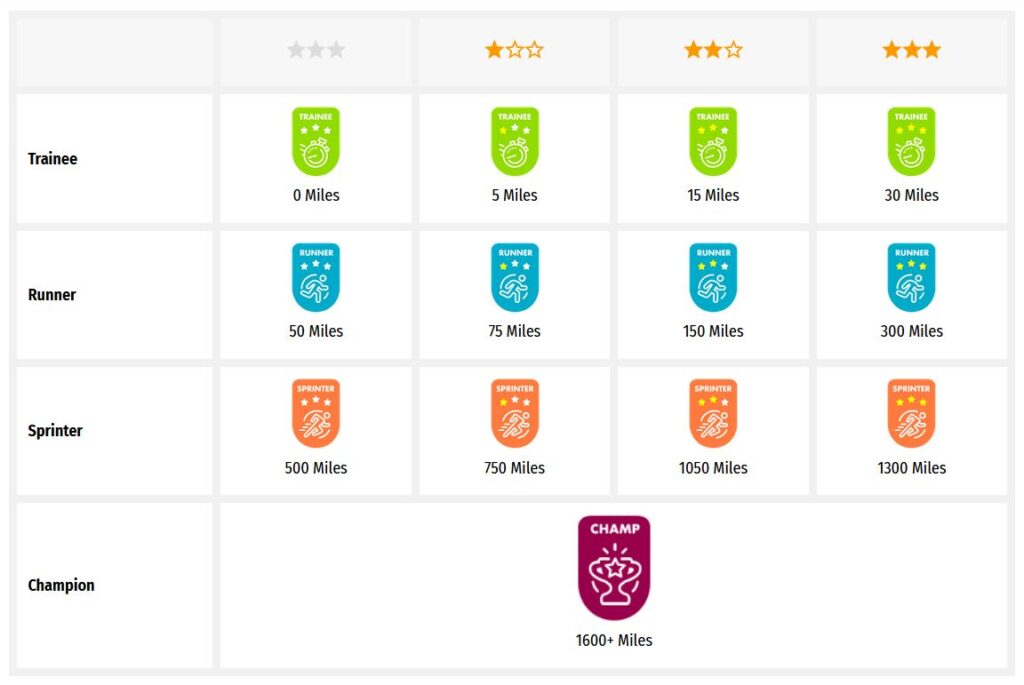Someone else is currently editing this document
Only one person can work on a document at a time
TRANSCRIPTION
Dienstag, den 11. August 14.
6.45 Uhr Antreten zum Übungsmarsch.
12 Uhr Rückkehr.
2 Uhr nachm. Gewehrappell
7 Uhr Löhnungsappell.
8 Uhr Zapfenstreich. Kurz darauf
stiller Probealarm. 1/4 Stunde
nachdem standen sämtliche Compagnien
feldmarschmäßig auf
dem Sammelplatze fertig angetreten.
Alle 5 - 10 Minuten passierten Züge
mit Truppen & Artillerie, die der Grenze zueilen.
Mittwoch, den 12. August 14.
6.15 Uhr Antreten zum Übungsmarsche, anschließend Übungen
im Gelände, Gefechts- & Vorposten-
rechte Seite
übungen.
3.20 Uhr nachm. Antreten zum Baden
in der Badeanstalt.
5 Uhr Apell in Fußbekleidung
und Stiefeln.
8 Uhr Zapfenstreich.
Donnerstag, den 13. August 14.
1/2 9 Uhr Abmarsch aus Gürzenich.
1/2 12 Uhr langten wir in Vossanak
i/d. Eifel an, bezogen daselbst
Bürgerquartiere.
Vossanak ist ein kl. Bauerndörfchen
die Gegend ist sehr gebirgig.
5 Uhr Appell in Füßen.
Täglich mehren sich die Fußkranken.
Freitag, den 14. August 14.
6 - 10.30 Uhr vorm. Übungsmarsch.
Language(s) of Transcription
LOCATION
Saint-Quentin, Frankreich (49.8472, 3.28745)
Story Location
ABOUT THIS DOCUMENT
Document Date
Document Type
Document Description
Language of Description
Keywords
External Web Resources
People
STORY INFORMATION
Title
Kriegstagebuch von Josef Delewe von 1914
Source
UGC
Contributor
europeana19141918:agent/93f12c9dfa8aefea5226770b2b776ae6
Date
1914-07-31
1914-11-08
Type
Story
Language
deu
Deutsch
Country
Europe
DataProvider
Europeana 1914-1918
Provider
Europeana 1914-1918
Rights
http://creativecommons.org/publicdomain/zero/1.0/ http://creativecommons.org/licenses/by-sa/3.0/DatasetName
2020601_Ag_ErsterWeltkrieg_EU
Begin
1914-07-31
End
1914-11-08
Language
mul
Agent
Josef Delewe | europeana19141918:agent/4228c3f95225b98baea2e99192e8f98d
Rudolf Drosten | europeana19141918:agent/93f12c9dfa8aefea5226770b2b776ae6
Created
2019-09-11T08:20:42.994Z
2020-02-25T08:22:47.303Z
2013-11-27 16:06:24 UTC
Provenance
BC18
Story Description
Kriegstagebuch von Josef Delewe, das er vom 31.07.1914 bis zum 08.11.1914 (obwohl er Anfangs schreibt: Meine Erlebnisse im Kriege 1914/15) führte. Er beginnt zunächst mit der Aufzählung der Kompanieführer, ehe er mit den Niederschriften seiner Kriegserlebnisse beginnt. Einleitend stehen folgende Zitate in seinem Tagebuch:Mit Gott für König und Vaterland!; In Not und Tod mit Gut und Blut Treu bis zum letzten Atemzug. Daran anschließend ist ein von ihm verfasstes Vorwort zu lesen.
Der Gefreite Josef Delewe, geboren um 1880/1890 in Papenburg, arbeitete als Lehrer, ehe er am 31. Juli 1914 zur 10. Kompanie des 3. Bataillons Infanterieregiment 159 nach Geldern zu einer achtwöchigen Übung eingezogen wurde. Delewe war an Kämpfen in Belgien und Frankreich (Teilnahme am Französischen Feldzug, um Maubeuge, Bouconville, Ailles, Saint-Quentin) beteiligt und beschreibt detailliert seine Erlebnisse im Krieg aus seiner persönlichen Perspektive. Er ordnete den Krieg in den Kontext der vorangegangenen Jahrzehnte ein und schreibt über das Kampfgeschehen, die Gefallenen und die Versetzungen von Kameraden. Z.B. erwähnt er, dass im November 1914 einer seiner Kameraden nach Russland an die Ostfront versetzt wurde.
Die Familie Delewe hatte niederländische Wurzeln. Ihr Name wurde eingedeutscht und lautete vorher de Lewe.
TRANSCRIPTION
LOCATION
DESCRIPTION
PEOPLE
STORY INFO
TUTORIAL
linke Seite
Dienstag, den 11. August 14.
6.45 Uhr Antreten zum Übungsmarsch.
12 Uhr Rückkehr.
2 Uhr nachm. Gewehrappell
7 Uhr Löhnungsappell.
8 Uhr Zapfenstreich. Kurz darauf
stiller Probealarm. 1/4 Stunde
nachdem standen sämtliche Compagnien
feldmarschmäßig auf
dem Sammelplatze fertig angetreten.
Alle 5 - 10 Minuten passierten Züge
mit Truppen & Artillerie, die der Grenze zueilen.
Mittwoch, den 12. August 14.
6.15 Uhr Antreten zum Übungsmarsche, anschließend Übungen
im Gelände, Gefechts- & Vorposten-
rechte Seite
übungen.
3.20 Uhr nachm. Antreten zum Baden
in der Badeanstalt.
5 Uhr Apell in Fußbekleidung
und Stiefeln.
8 Uhr Zapfenstreich.
Donnerstag, den 13. August 14.
1/2 9 Uhr Abmarsch aus Gürzenich.
1/2 12 Uhr langten wir in Vossanak
i/d. Eifel an, bezogen daselbst
Bürgerquartiere.
Vossanak ist ein kl. Bauerndörfchen
die Gegend ist sehr gebirgig.
5 Uhr Appell in Füßen.
Täglich mehren sich die Fußkranken.
Freitag, den 14. August 14.
6 - 10.30 Uhr vorm. Übungsmarsch.
- Deutsch (German)
Dienstag, den 11. August 14.
6.45 Uhr Antreten zum Übungsmarsch.
12 Uhr Rückkehr.
2 Uhr nachm. Gewehrappell
7 Uhr Löhnungsappell.
8 Uhr Zapfenstreich. Kurz darauf
stiller Probealarm. 1/4 Stunde
nachdem standen sämtliche Compagnien
feldmarschmäßig auf
dem Sammelplatze fertig angetreten.
Alle 5 - 10 Minuten passierten Züge
mit Truppen & Artillerie, die der Grenze zueilen.
Mittwoch, den 12. August 14.
6.15 Uhr Antreten zum Übungsmarsche, anschließend Übungen
im Gelände, Gefechts- & Vorposten-
rechte Seite
übungen.
3.20 Uhr nachm. Antreten zum Baden
in der Badeanstalt.
5 Uhr Apell in Fußbekleidung
und Stiefeln.
8 Uhr Zapfenstreich.
Donnerstag, den 13. August 14.
1/2 9 Uhr Abmarsch aus Gürzenich.
1/2 12 Uhr langten wir in Vossanak
i/d. Eifel an, bezogen daselbst
Bürgerquartiere.
Vossanak ist ein kl. Bauerndörfchen
die Gegend ist sehr gebirgig.
5 Uhr Appell in Füßen.
Täglich mehren sich die Fußkranken.
Freitag, den 14. August 14.
6 - 10.30 Uhr vorm. Übungsmarsch.
Language(s) of Transcription
English Translation
Transcription History
linke Seite Dienstag, den 11. August 14. 6.45 Uhr Antreten zum Übungsmarsch. 12 Uhr Rückkehr. 2 Uhr nachm. Gewehrappell 7 Uhr Löhnungsappell. 8 Uhr Zapfenstreich. Kurz darauf stiller Probealarm. 1/4 Stunde nachdem standen sämtliche Compagnien feldmarschmäßig auf dem Sammelplatze fertig angetreten. Alle 5 - 10 Minuten passierten Züge mit Truppen & Artillerie, die der Grenze zueilen. Mittwoch, den 12. August 14. 6.15 Uhr Antreten zum Übungsmarsche, anschließend Übungen im Gelände, Gefechts- & Vorposten- rechte Seite übungen. 3.20 Uhr nachm. Antreten zum Baden in der Badeanstalt. 5 Uhr Apell in Fußbekleidung und Stiefeln. 8 Uhr Zapfenstreich. Donnerstag, den 13. August 14. 1/2 9 Uhr Abmarsch aus Gürzenich. 1/2 12 Uhr langten wir in Vossanak i/d. Eifel an, bezogen daselbst Bürgerquartiere. Vossanak ist ein kl. Bauerndörfchen die Gegend ist sehr gebirgig. 5 Uhr Appell in Füßen. Täglich mehren sich die Fußkranken. Freitag, den 14. August 14. 6 - 10.30 Uhr vorm. Übungsmarsch.
linke Seite Dienstag, den 11. August 14. 6.45 Uhr Antreten zum Übungsmarsch. 12 Uhr Rückkehr. 2 Uhr nachm. Gewehrappell 7 Uhr Löhnungsappell. 8 Uhr Zapfenstreich. Kurz darauf stiller Probealarm. 1/4 Stunde nachdem standen sämtliche Compagnien feldmarschmäßig auf dem Sammelplatze fertig angetreten. Alle 5 - 10 Minuten passierten Züge mit Truppen & Artillerie, die der Grenze zueilen. Mittwoch, den 12. August 14. 6.15 Uhr Antreten zum Übungsmarsche, anschließend Übungen im Gelände, Gefechts- & Vorposten- rechte Seite übungen. 3.20 Uhr nachm. Antreten zum Baden in der Badeanstalt. 5 Uhr Apell in Fußbekleidung und Stiefeln. 8 Uhr Zapfenstreich. Donnerstag, den 13. August 14. 1/2 9 Uhr Abmarsch aus Grüzenich. 1/2 12 Uhr langten wir in Vossanak i/d. Eifel an, bezogen daselbst Bürgerquartiere. Vossanak ist ein kl. Bauerndörfchen die Gegend ist sehr gebirgig. 5 Uhr Appell in Füßen. Täglich mehren sich die Fußkranken. Freitag, den 14. August 14. 6 - 10.30 Uhr vorm. Übungsmarsch.
linke Seite Dienstag, den 11. August 14. 6.45 Uhr Antreten zum Übungsmarsch. 12 Uhr Rückkehr. 2 Uhr nachm. Gewehrappell 7 Uhr Löhnungsappell. 8 Uhr Zapfenstreich. Kurz darauf stiller Probealarm. 1/4 Stunde nachdem standen sämtliche Compagnien feldmarschmäßig auf dem Sammelplatze fertig angetreten. Alle 5 - 10 Minuten passierten Züge mit Truppen & Artillerie, die der Grenze zueilen. Mittwoch, den 12. August 14. 6.15 Uhr Antreten zum Übungsmarsche, anschließend Übungen im Gelände, Gefechts- & Vorposten- rechte Seite übungen. 3.20 Uhr nachm. Antreten zum Baden in der Badeanstalt. 5 Uhr Apell in Fußbekleidung und Stiefeln. 8 Uhr Zapfenstreich. Donnerstag, den 13. August 14. 1/2 9 Uhr Abmarsch aus Grüzenich. 1^/2 12 Uhr langten wir in Vossanak
English Translation
War diary of Josef Delewe, which he kept from July 31, 1914 to November 8, 1914 (although he writes at the beginning: My experiences in the war 1914/15).
He begins by listing the company commanders before beginning to write down his wartime experiences.
The following quotations are introduced in his diary: With God for king and fatherland!; In distress and death with property and blood Loyal to the last breath.
This is followed by a foreword written by him. || Private Josef Delewe, born around 1880/1890 in Papenburg, worked as a teacher before he was drafted into the 10th Company of the 3rd Battalion, Infantry Regiment 159 in Geldern on July 31, 1914 for an eight-week exercise.
Delewe took part in battles in Belgium and France (participation in the French campaign around Maubeuge, Bouconville, Ailles, Saint-Quentin) and describes in detail his experiences in the war from his personal perspective.
He places the war in the context of the preceding decades and writes about what happened in the battle, the casualties and the transfers of comrades.
For example, he mentions that in November 1914 one of his comrades was transferred to the Eastern Front in Russia.
The Delewe family had Dutch roots.
Her name was Germanized and was previously de Lewe.
Automatically Identified Enrichments
Verify Automatically Identified Enrichments
Verify Automatically Identified Locations
Verify Automatically Identified Persons
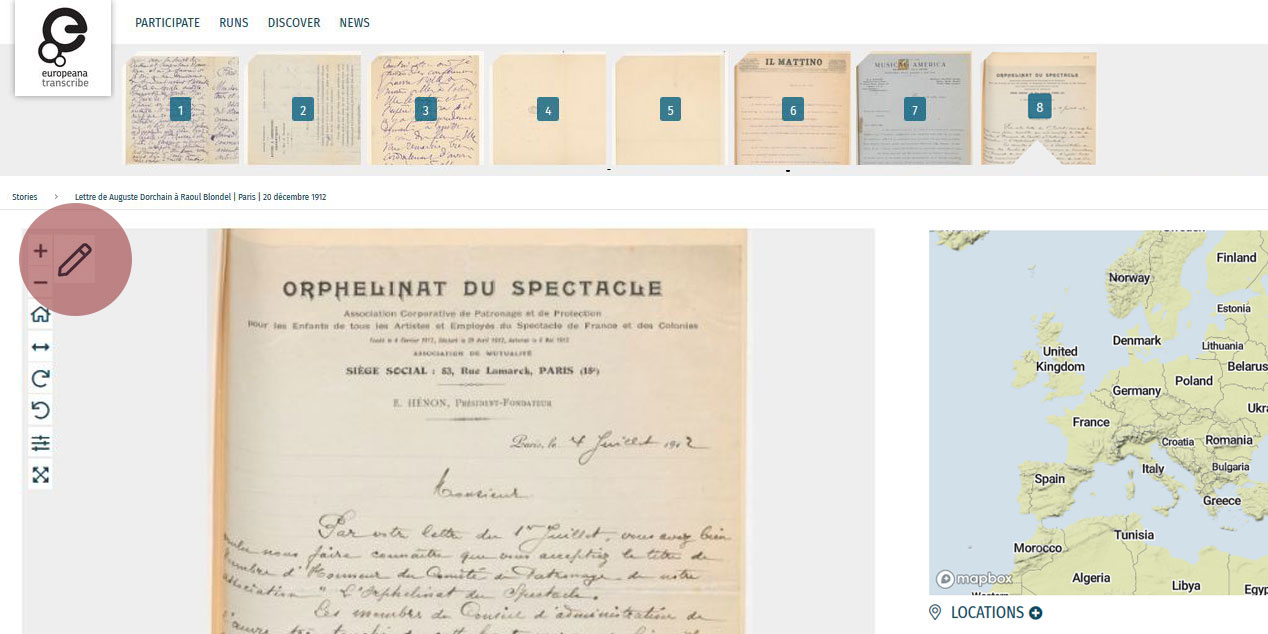
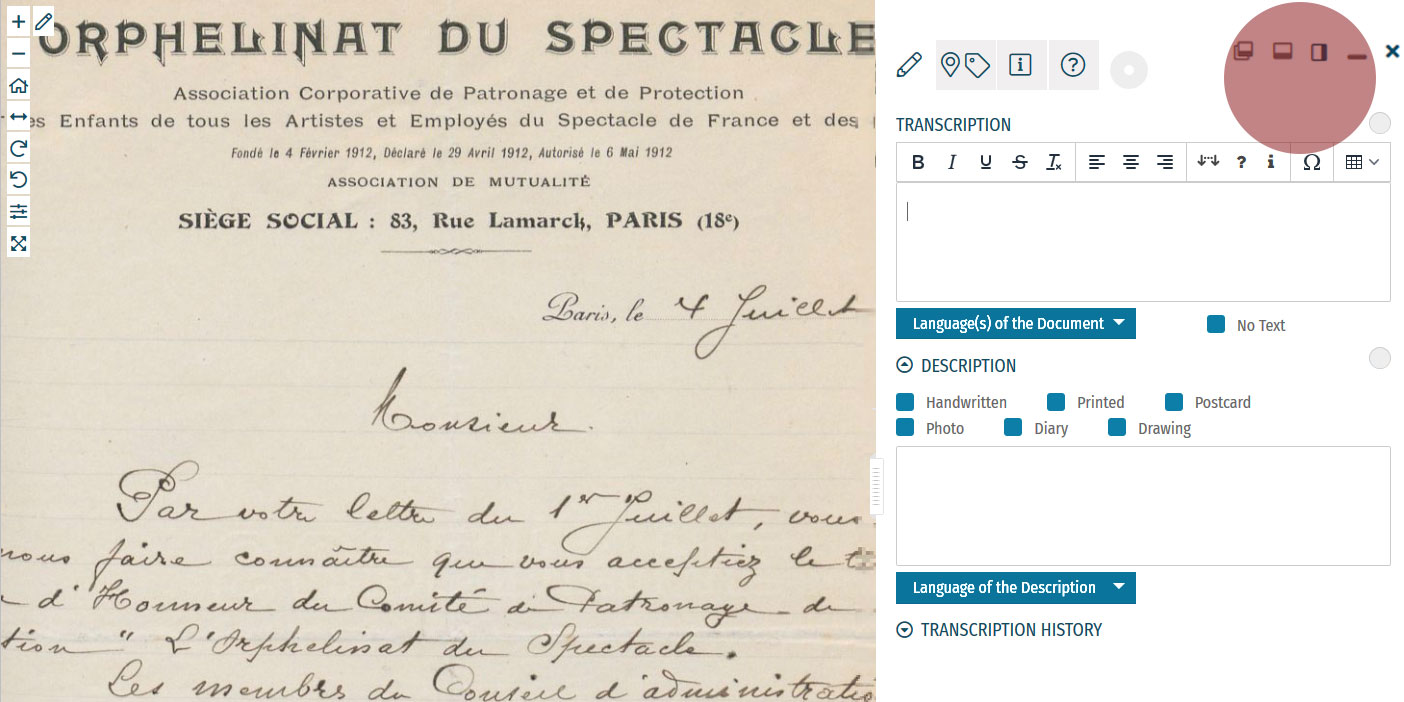
Enrichment Mode
Edit your workspace view by using the top-right menu.
You can have the white Activity Panel docked to the right (default) , to the bottom , or as an independent overlay . If you just want to view the image, you can hide the panel using the minimise button , and then re-open it with the pen button. Adjust the size and position of your Activity Panel according to your preferences.
You enrich documents by following a step-by-step process.
Make sure you regularly save your enrichments in each step to avoid the risk of losing your work.

Step 1: Transcription
To start a transcription, select the transcription tab at the top menu of the Activity Panel. Click inside the box underneath the heading TRANSCRIPTION and start writing your transcription. When needed, use the toolbar to format your text and to add special characters and tables. A guide to the transcription toolbar is available in the Formatting section of this tutorial.
Identify the language(s) of the text using the dropdown list under the transcription box. You can select multiple languages at once.
If the item has no text to transcribe, tick the checkbox ‘No Text’.
Once you have finished your transcription, click SAVE.
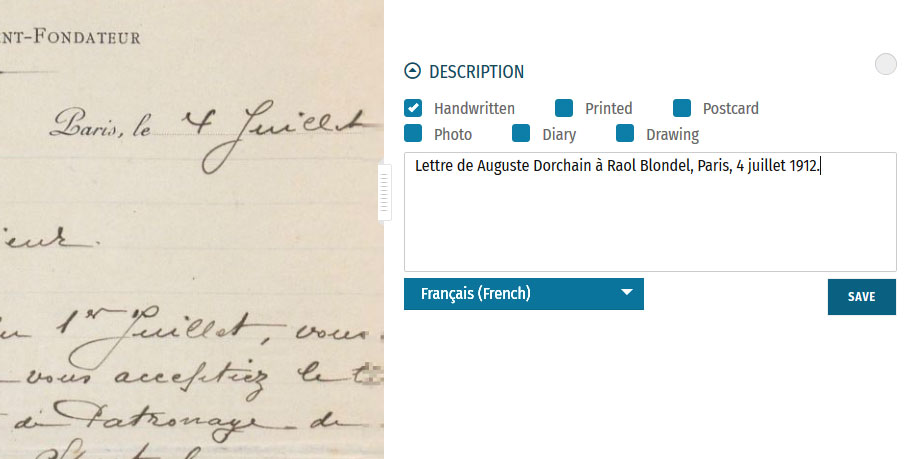
Step 2: Description
You can add a description to the item underneath the Transcription section.
The first task is to identify what type of document the item is: a handwritten or printed document, a postcard, photo, drawing and/or part of a diary. Tick the category which best applies to the item. Multiple categories can be selected at once.
The second task is to write a description of the contents. Click inside the box underneath the heading DESCRIPTION. Here, you can write what the item is, what it is about, and specify the images and objects that appear in the item.
Identify the language of the description text that you wrote using the dropdown list underneath. You can only select one language.
Once you have finished your description, click SAVE.
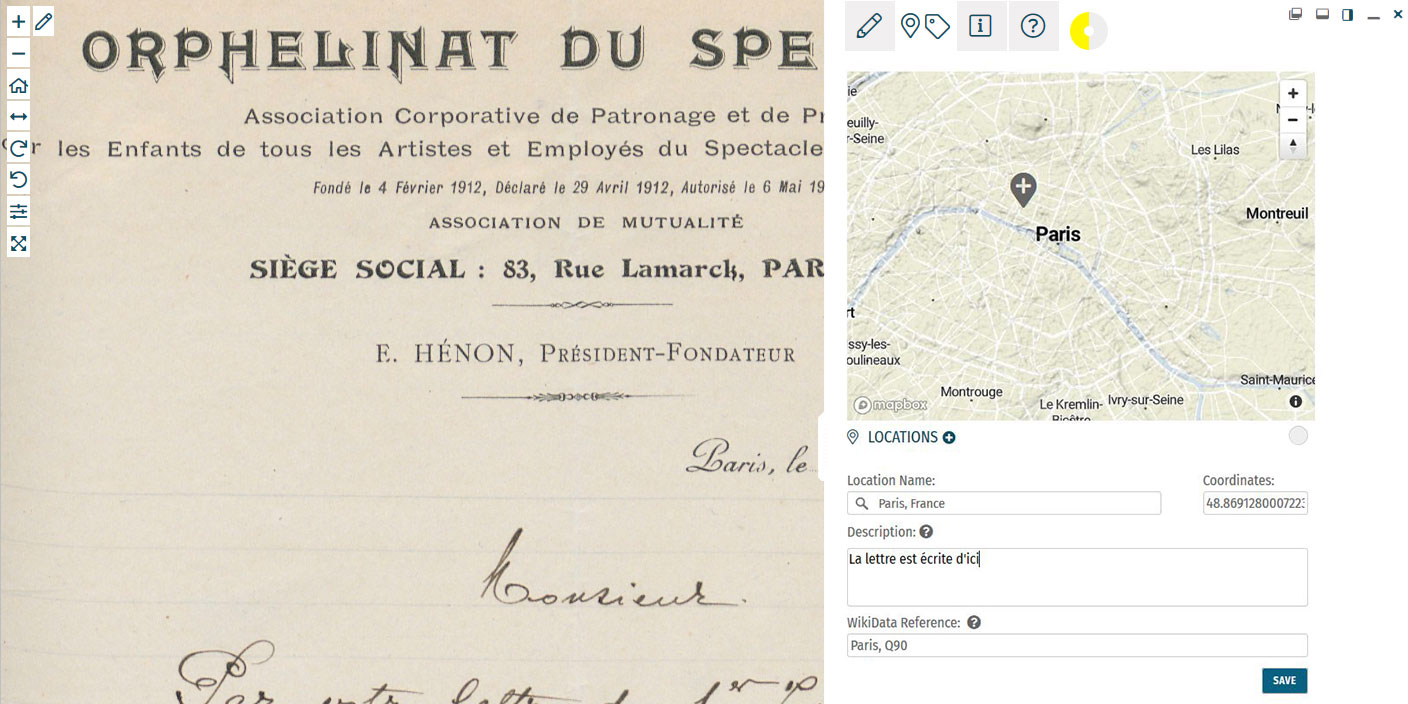
Step 3: Location
If you find a location mentioned or recognise a place in the item, you can create a geotag and pin it to the item map. Multiple locations can be attached to the item. To tag locations, select the tagging tab at the top menu of the Activity Panel. Click the plus next to the heading LOCATIONS. Type the location into the search bar and select the result that best applies. A new pin will be placed into the map. The location name should be a clear georeference, e.g. a country, city or address. Make adjustments to the location name if necessary. You can also adjust the position of the pin by dragging it on the map. If you want to add further details to the location, you can write a (short) description. This could include extra information about the geotag (e.g. the building name or a significant event that took place at the location) or the relevance of the place to the item (e.g. the hometown of the author). You can also add a Wikidata reference to link the location to a stable source. Search for the reference using the Wikidata fields. Once you have finished your location tag, click SAVE. You can find the place(s) tagged to the item in grey at the bottom of the Location(s) section.Step 4: Tagging
Below the Locations section is the Tagging section, where you can add the following annotations:
 Document Date:
Document Date:Here, you can add dates that correspond to the item. This could include the dates mentioned in the text (e.g. in diary pages), the date of a related historical event (e.g. the end of WWI), or when the item was created (e.g. from a dated signature on an illustration). You can either define this as a single date or as a longer time frame.
To tag dates to the item, write the start and end dates in DD/MM/YYYY format in the fields or select the dates by clicking on the calendar.
If you only have one date to add, insert the same date into both start and end fields.
If you don’t know the exact days, you can also tag the date on the scale of months (MM/YYYY) or years (YYYY).
Once you have finished your date tag, click SAVE DATE.
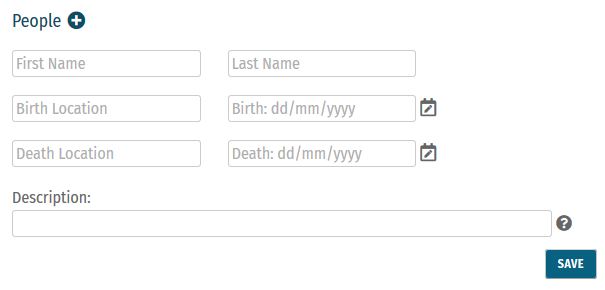 People:
People:People mentioned as creators or subjects in the item can also be tagged. Depending on the information you might have, you can enter the person’s first and last names, as well as their dates of birth and death. There is also the option to write a short description of the person, explaining who they are or their relevance to the item, e.g. the person’s occupation or their relation to another tagged person.
Multiple people can be tagged to one item.
Once you have finished your person tag, click SAVE.
 Keywords:
Keywords:Here, you can freely add keywords related to the topic and content of the item. This could include particular themes (e.g. art, music, war), subjects (e.g. children, cooking, France), or particular historical affiliations (e.g. 20th century, Austro-Hungarian Empire, Fall of the Iron Curtain).
Multiple keywords can be added and they can be written in any language.
Write your keyword tag into the field and click SAVE.
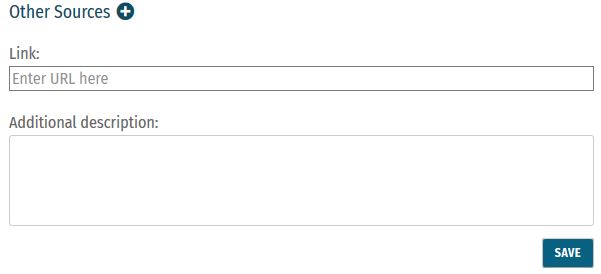 Other Sources:
Other Sources:External websites with information about the item’s content can be linked here. This could include links to further data about a person mentioned, a particular historical event or links to digital versions of newspapers that appear in photos or clippings in a notebook.
To add a link, click the plus next to the heading ‘Other Sources’. Enter the URL into the Link field, and write a short description of this link in the Additional Description field.
Multiple links can be tagged to one item.
Once you have finished your tag, click SAVE.
Step 5: Mark for Review
Once you have saved your contribution, the task will automatically change to the Edit status. If you think the task is finished, you can mark it for review. Note that you have to be at Runner level or above to do this (see: Miles and Levels). Click on the yellow circle next to the section heading and select Review in the list that appears. The task now needs to go under Review by another volunteer.Formatting
Review
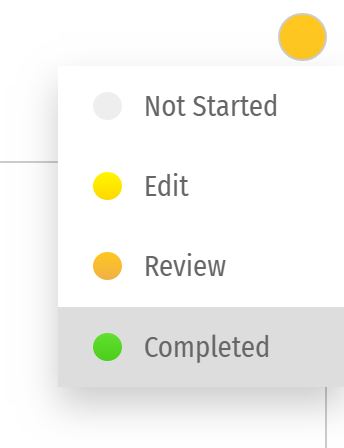 All enrichments need to be edited and reviewed by more than one volunteer to ensure that they are as accurate as possible.
Only Sprinters and Champions can edit tasks in the Review stage and mark them as Complete. (see: Miles and Levels)
You can review a task (Transcription, Description, Locations, or Tagging) when the circle next to the heading is coloured orange .
During the review process, pay close attention to the following requirements:
All enrichments need to be edited and reviewed by more than one volunteer to ensure that they are as accurate as possible.
Only Sprinters and Champions can edit tasks in the Review stage and mark them as Complete. (see: Miles and Levels)
You can review a task (Transcription, Description, Locations, or Tagging) when the circle next to the heading is coloured orange .
During the review process, pay close attention to the following requirements:
-
- Transcription: The complete text in the item has been properly transcribed and the transcription is formatted as accurately as possible. The correct language(s) are selected and the transcription contains no missing or unclear icons.
-
- Description: The description is accurate and detailed (especially items without text to transcribe, e.g. photos), and the appropriate categories have been ticked.
-
- Location(s): All locations have been correctly tagged. The location name is accurate and matches the coordinates and the pin on the map. The description is clear and concise, and the Wikidata reference (if any) is correct.
-
- Tagging: Document dates are completed and as precise as possible. All mentioned people are tagged and their data is correct. All added keywords are applicable to the item, and other sources have accurate information and functioning links.
Completion Statuses
| GREY |
| 1. NOT STARTED |
| Tasks have not been started. |
| YELLOW |
| 2. EDIT MODE |
| Tasks have been started, but not yet finished. Additions and edits can still be made. |
| ORANGE |
| 3. REVIEW |
| Tasks are finished, but need final review by Sprinter or Champion transcribers. |
| GREEN |
| 4. COMPLETED |
| Tasks have been fully completed and reviewed. No further changes need to be made. |
Miles and Levels
Transcribathon is a competitive marathon. You do not enrich documents alone, but compete and work with other volunteers to ensure the quality of your work. When you first create a Transcribathon account, you only have the ability to start and edit tasks. The more you enrich documents, the closer you become to advancing to a higher level, which can unlock abilities like reviewing and completing tasks.| Level | Abilities |
|---|---|
| Trainee | Basic abilities: start and edit tasks |
| Runner | Basic abilities, mark finished tasks for review |
| Sprinter | All Runner abilities, mark reviewed annotations as completed |
| Champion | All Sprinter abilities, mark reviewed transcriptions as completed |
| Tasks | Miles Received |
|---|---|
| Transcription | 1 Mile for every 300 characters transcribed |
| Description | 1 Mile for every 5 Descriptions added |
| Location | 1 Mile for every 5 Locations added |
| Tagging | 1 Mile for every 5 Tags added |
| Reviewing | 1 Mile for every 10 items marked as complete |
